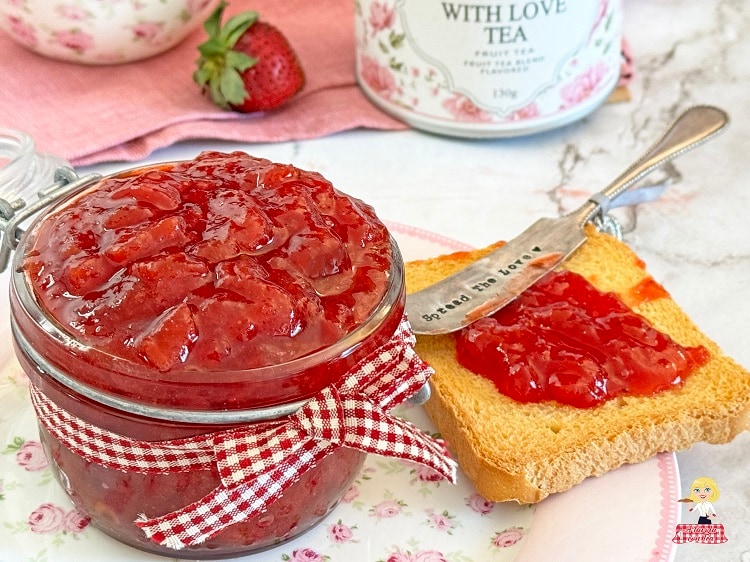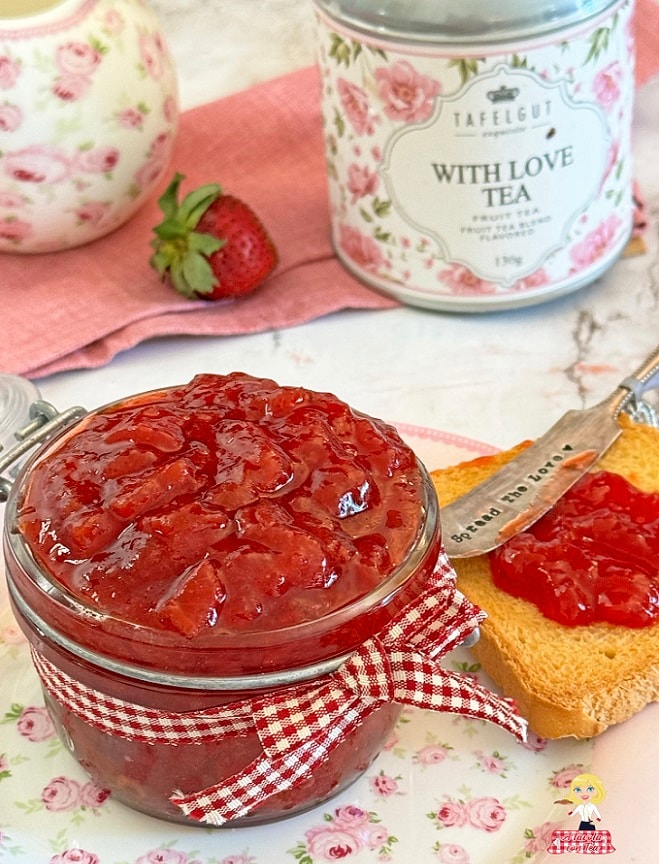STRAWBERRY JAM
The Strawberry Jam or more correctly it should be called Strawberry Preserves (with the term “Jam” referring only to citrus-based products) is perhaps my favorite sweet preserve and appreciated by my family.
It is ideal for breakfast in the morning spread on bread or toast, but due to its versatility, it is also excellent for filling cakes, tarts, pies, or rolls, although I confess that sometimes I simply enjoy eating it by the spoonful!
The Recipe is very simple and it’s the traditional one we’ve been preparing for years in our family.
It doesn’t present particular difficulties; the only thing it requires is a bit of time to carry out the steps, respect the cooking times, and safely proceed with vacuum sealing.
The ingredients to prepare the Strawberry Jam… oops Strawberry Preserves at home are few and simple: fresh strawberries, sugar (not less than 50% of the weight of the fruit to ensure safe preservation from a health perspective and to avoid the formation of botulinum, as well as the longevity of our preparation).
To obtain a Strawberry Preserves with just the right compactness without adding artificial thickeners, it will be enough to add some lemon peel, rich in pectin, to the strawberries placed to marinate for a few hours or even better, a day before.
The result will amaze you; you will get a fragrant, fresh, delicious strawberry jam with an intense flavor in which the lemon does not disturb but balances the sweetness of the fruit and sugar without being noticeable on the palate.
Follow this recipe for Homemade Strawberry Jam and thanks to fresh and genuine ingredients, you will create a sweet preserve with a rich and full-bodied consistency, much better than the one bought at the supermarket but most importantly, genuine!

- Difficulty: Easy
- Cost: Economical
- Rest time: 5 Hours
- Preparation time: 20 Minutes
- Portions: 4 jars
- Cooking methods: Stove
- Cuisine: Italian
- Energy 59.88 (Kcal)
- Carbohydrates 15.63 (g) of which sugars 14.37 (g)
- Proteins 0.30 (g)
- Fat 0.13 (g) of which saturated 0.01 (g)of which unsaturated 0.08 (g)
- Fibers 0.92 (g)
- Sodium 0.67 (mg)
Indicative values for a portion of 2 g processed in an automated way starting from the nutritional information available on the CREA* and FoodData Central** databases. It is not food and / or nutritional advice.
* CREATES Food and Nutrition Research Center: https://www.crea.gov.it/alimenti-e-nutrizione https://www.alimentinutrizione.it ** U.S. Department of Agriculture, Agricultural Research Service. FoodData Central, 2019. https://fdc.nal.usda.gov
Ingredients
- 4 cups strawberries (weight after cleaning)
- 3/4 cup sugar
- 3.4 oz lemon juice
- 1 lemon peel
Tools
- Bowl
- Strainer
- Pot
- 4 Jars
Steps
Gently wash the strawberries under running water without soaking them, then dry them with a kitchen towel. Remove the stem and cut them in half. Squeeze the lemon juice and strain half of it through a fine strainer. Put the strawberries, sugar, juice of 1/2 lemon with its peel in a large bowl. Mix to coat the strawberries. Cover the bowl with plastic wrap and leave it in the fridge for at least 7 hours but no more than 12, otherwise, they will macerate too much.
After the marination time, transfer the strawberry, sugar, and lemon mixture to a large pot, removing the peels. Place on the stove over moderate heat and bring to a boil, occasionally stirring with a spatula. If necessary, remove the foam from the surface so that your preserves do not appear dull. Let it boil over moderate heat for about 30-40 minutes.
Proceed to jar the preserves, still hot, in jars that must be previously sanitized. Do not fill them to the brim but leave about 1 cm of space. Screw the lids tightly and let them cool. The heat of the preserves will create the vacuum. Once the jars have cooled, check if the vacuum has formed. To do this, press the center of the lid, and if you hear the classic “click-clack,” the vacuum has occurred.

NOTES
STRAWBERRIES The ideal strawberries for making Preserves should be deep red, not unripe but not too ripe either, obviously free of mold but also free of bruises or signs of decay. If you find fruits with even small bruises, I recommend cleaning them and removing the soft or damaged parts.
STRAWBERRY MARINATION If you have the time, I recommend marinating the strawberries the day before preparing the Preserves because the aroma and taste of the strawberries will be more intense, and this process will help the Strawberry Jam to have a denser and less liquid consistency, as lemon peels are rich in pectin, a natural thickening agent. If you don’t have much time, let them marinate for only 2 hours.
COOKING VERIFICATION Since strawberries contain very little pectin, which promotes the density of preserves during cooking, the jam prepared with this fruit tends to be slightly more liquid than others. To check if your preserves are ready, I recommend, once the indicated cooking time has elapsed, taking a drop with a spoon and letting it fall onto a plate: if tilting the plate the drop shows slight resistance and does not “slide” too much, it means the preserves are ready.
STORAGE
Strawberry preserves, if the vacuum has been correctly formed, can be stored for up to 3 months in a cool, dry place away from light sources. To best appreciate your sweet strawberry preserves, I recommend waiting 2 weeks, from when you prepared it, before consuming it. Once a jar is opened, without artificial preservatives, you must store it in the refrigerator and consume it within 3-4 days at most.
FOR A CORRECT PREPARATION OF HOMEMADE PRESERVES
For a correct preparation of homemade preserves, I recommend reading the guidelines of the Ministry of Health which contain not only hygiene rules but also how to handle ingredients, their storage, and pasteurization to avoid health risks.
FAQ (Questions and Answers)
WHICH STRAWBERRIES TO CHOOSE FOR MAKING JAM – PRESERVES?
Fresh strawberries, preferably Italian, deep red in color, not unripe but not too ripe either, obviously free of mold but also free of bruises or signs of decay. Ideally, they should be used as soon as purchased. The longer this fruit stays in the fridge, the more it will be subject to deterioration.
HOW TO CHECK IF THE JAM OR PRESERVES HAS FORMED A VACUUM?
What creates the vacuum is the heat of the preserves, which must be put inside the jars just prepared and immediately sealed tightly. To check if the jam has formed a vacuum, once the jars have cooled, press the center of the lid, and if you hear the classic “click-clack,” the vacuum has occurred.

